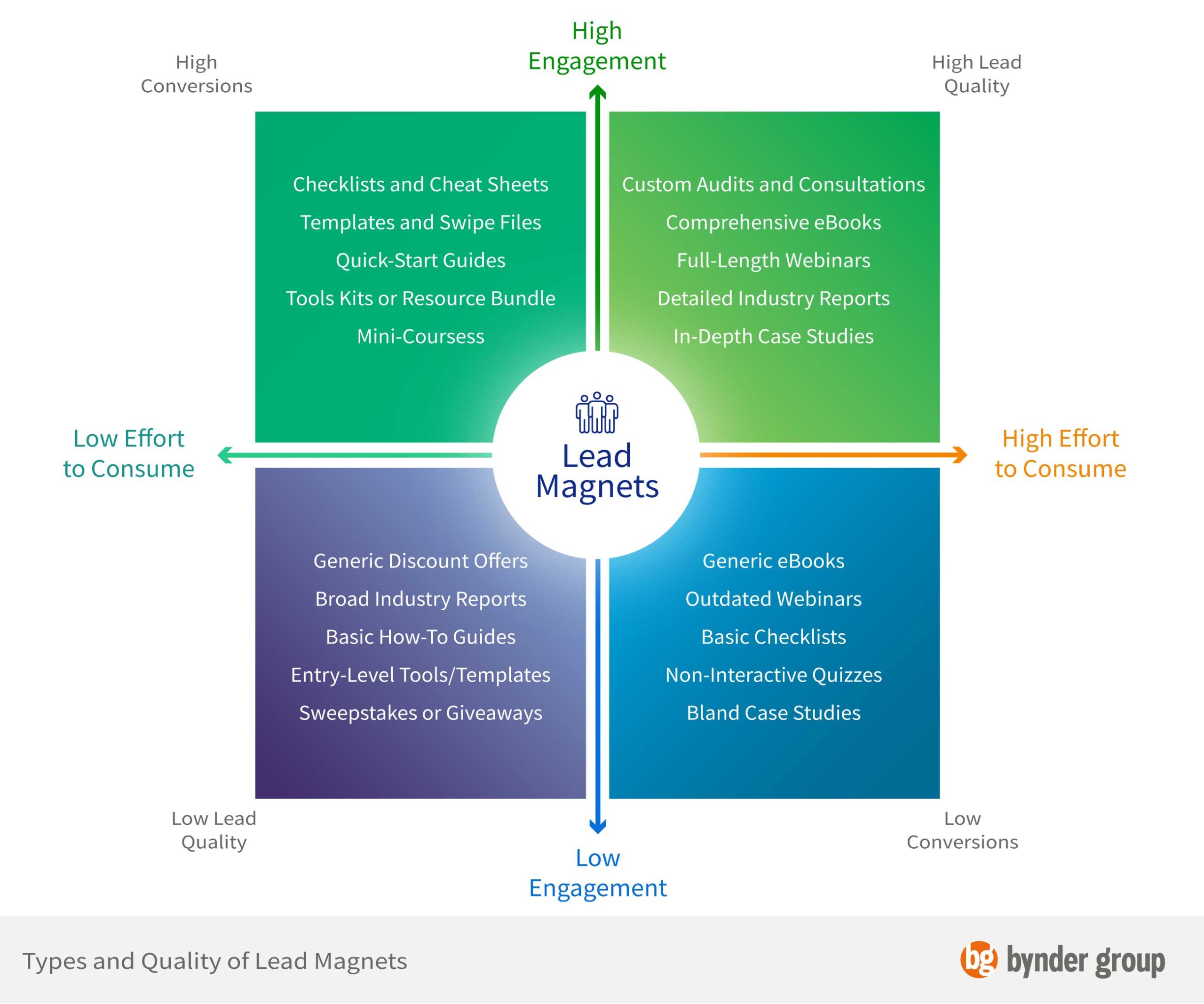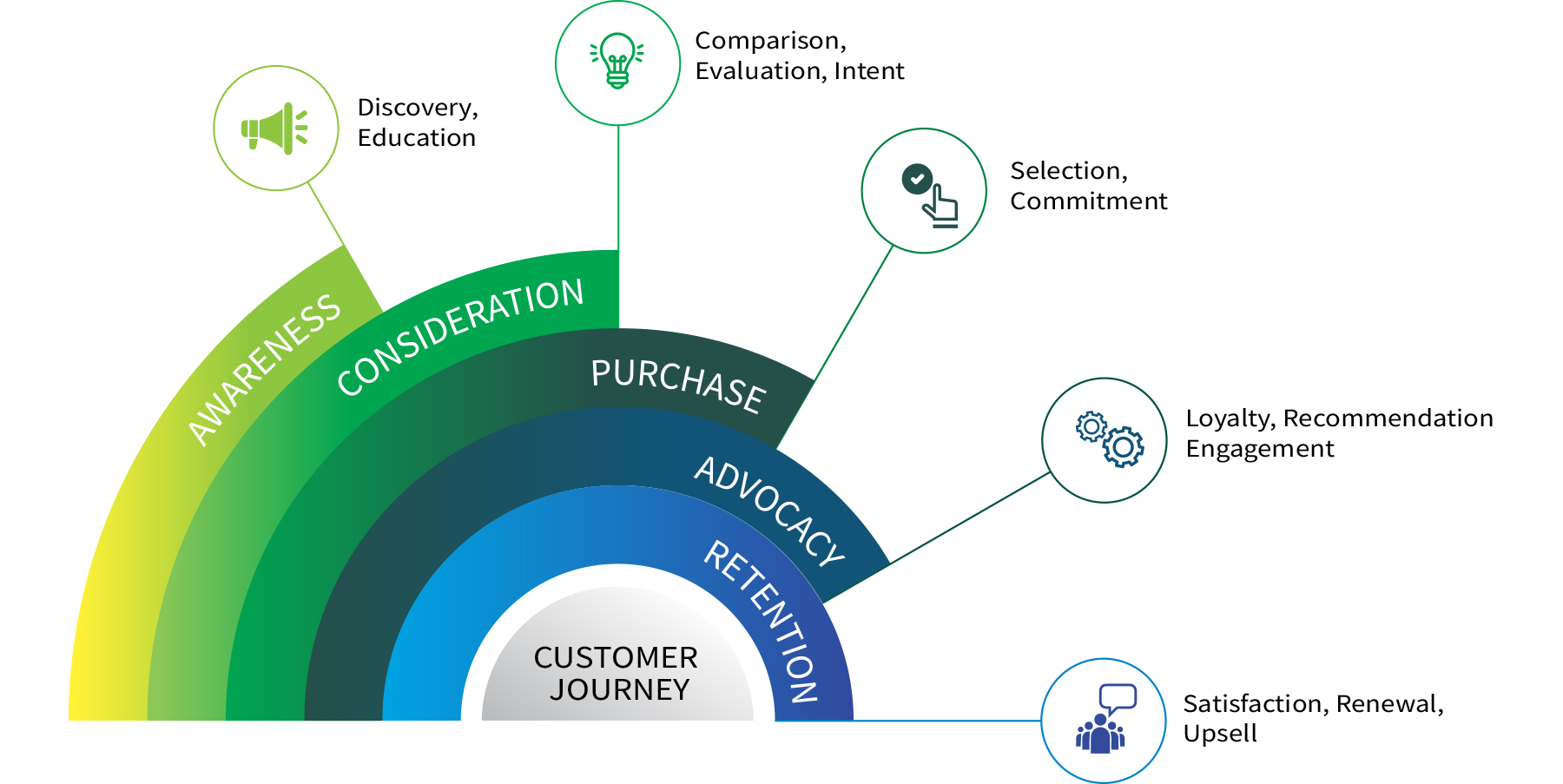Effective Use of Lead Magnets in 2024
While some may say that lead magnets have become less effective in an increasingly saturated digital landscape, they remain a valuable tool for engaging potential customers and nurturing them through the acquisition funnel, particularly in inbound marketing. However, their effectiveness has evolved, and marketers must adapt their approach to remain competitive.
Lead magnets continue to be valuable for several reasons:
-
- Value exchange: They provide a clear value proposition to potential customers in exchange for their contact information.
- Audience segmentation: Lead magnets help identify interested prospects and their specific pain points or interests.
- Trust building: By offering valuable content upfront, businesses can establish credibility and expertise.
- Nurturing opportunities: They create a basis for follow-up communications and relationship building.
That said, the landscape has changed:
-
- Content saturation: With the proliferation of online content, lead magnets need to be increasingly high-quality and unique to stand out.
- Privacy concerns: Users are more cautious about sharing personal information, so the perceived value of the lead magnet must be higher.
- Personalization: Generic lead magnets are less effective; tailored, persona-specific offerings perform better.
- Format diversity: While ebooks and whitepapers are still used, interactive tools, quizzes, and video content are gaining traction.
- Micro-conversions: Some businesses are moving towards a series of smaller commitments rather than one big lead magnet.
To maximize the effectiveness of lead magnets in today’s market:
-
- Focus on solving specific problems for your target audience.
- Ensure the content is genuinely valuable and not readily available elsewhere.
- Align the format with your audience’s preferences and consumption habits.
- Use lead magnets as part of a broader content strategy, not in isolation.
- Continuously test and refine your offerings based on performance data.
Lead magnets remain a relevant tool in the inbound marketing toolkit, but their implementation requires more strategic thinking and a keen understanding of audience needs to be truly effective.
Lead Magnets and Inbound Marketing
Effective use of lead magnets can significantly enhance your prospect acquisition strategies and bolster your inbound marketing efforts, giving your business a competitive edge. By offering valuable content or incentives in exchange for contact information, you create a mutually beneficial transaction that nurtures trust and interest in your brand. This approach helps build a robust email list and allows for more personalized and targeted marketing efforts. Understanding and implementing the right lead magnets can streamline your sales funnel, ensuring prospects are engaged, informed, and likely to convert into loyal customers.
What is a Lead Magnet?
A lead magnet is a strategic tool designed to capture leads by offering valuable, in-depth content in exchange for a prospect’s contact information. These lead magnets often include ebooks, white papers, templates, and other downloadable resources.
A webinar is a powerful example of a lead magnet due to its interactive and educational nature. By hosting a webinar, your business can offer valuable insights, training, or discussions on relevant topics. Prospects register with their contact information to gain access, allowing you to capture leads efficiently and provide them with valuable content and information.
Lead Magnets Generate More Than Leads
In addition to being part of your marketing strategy, lead magnets are also a crucial component of a comprehensive demand generation strategy. They serve as the initial touchpoint that attracts potential customers into your marketing funnel by addressing their needs and interests. By offering valuable content or incentives, lead magnets help create awareness about your brand and its offerings. This early engagement is essential for building a relationship with prospects and nurturing them through the buyer’s journey.
Components of a High-Performing Lead Magnet
Focus on One Problem
Keep it simple and focus on helping your target audience solve a single problem. By addressing one pain point, you can provide a clear and concise solution that prospects can easily digest. This approach builds trust in your brand’s expertise and encourages further engagement.
Provide Value
Your lead magnet should offer valuable content that is not easily found elsewhere. It should be high-quality, actionable, and relevant to your target audience’s needs. This value exchange cultivates a positive brand experience right from the start and encourages prospects to continue engaging with your business.
Specific Call-to-Action (CTA)
A lead magnet should always include a specific call-to-action that directs prospects toward the next step in the sales funnel. Whether it’s signing up for a free consultation, scheduling a demo, or subscribing to your email list, the CTA should be clear and compelling.
Invest in Great Design
A well-designed and on-brand lead magnet creates a positive first impression on prospects, making them more likely to engage with your content. Quality design also amplifies the perceived value of your lead magnet and reflects positively on your brand’s professionalism.
Tips to Optimize Your Lead Magnets
Know Your Target Audience
To effectively use lead magnets, you must understand your target audience’s pain points, interests, and preferences. Investing in market research and creating detailed buyer personas will help you tailor your lead magnet to meet specific needs and attract the right prospects.
Use Personalization
Personalization is key in today’s digital landscape. With so much content available online, consumers crave personalized experiences that cater to their individual needs. By using data from your lead magnet’s registration form, you can personalize future communication and content to better resonate with prospects.
Promote Effectively
There are many channels to promote your lead magnet. Option channels include owned media, paid media, and earned media. Owned media include your website, blog, and social media platforms. Paid media encompasses advertising on Google or social media platforms. Earned media includes mentions in the press or influencer endorsements.
Owned Media
Using owned media like your website, blog, and social media channels is generally low-cost or free, allowing full control over content, timing, and frequency of promotions, ensuring brand consistency. However, the reach is limited to your existing audience, which may not be expansive, and regularly creating and updating content can be time-consuming and resource-intensive.
Paid Media
Paid media, such as Google ads and social media advertising, offers the advantage of expanded reach, precise targeting, and quick results. However, it comes with drawbacks like high costs, temporary impact requiring ongoing investment, and the risk of ad fatigue, where audiences become less responsive over time.
Earned Media
Earned media offers credibility through third-party validation from press mentions or influencer endorsements, enhancing trust with potential leads. It extends organic reach via shares and word-of-mouth and is cost-effective compared to paid promotions. However, it comes with challenges like lack of control over brand presentation, unpredictability in campaign success, and the time-consuming nature of building relationships with journalists and influencers.
Your Lead Magnet Worked… Now What?
After capturing leads with your lead magnets, nurturing them through email marketing is essential. By segmenting your email list according to the lead magnet they subscribed to, you can deliver targeted and personalized content that guides them further down the sales funnel. This process typically includes offering additional valuable content, creating personalized email sequences, and engaging timely to build trust and establish a strong relationship.
Improve Your Lead Generation with Lead Magnets
Lead magnets are a highly effective and cost-effective marketing tactic for prospect acquisition when implemented correctly. They provide value to both the business and prospects by fostering trust, building connections, and streamlining the sales funnel process.
By understanding your target audience and utilizing effective promotional channels, you can leverage lead magnets to attract and nurture high-quality leads that are likely to convert into loyal customers. So, it’s important to invest time and resources in creating high-quality lead magnets that align with your business goals and target audience needs.











